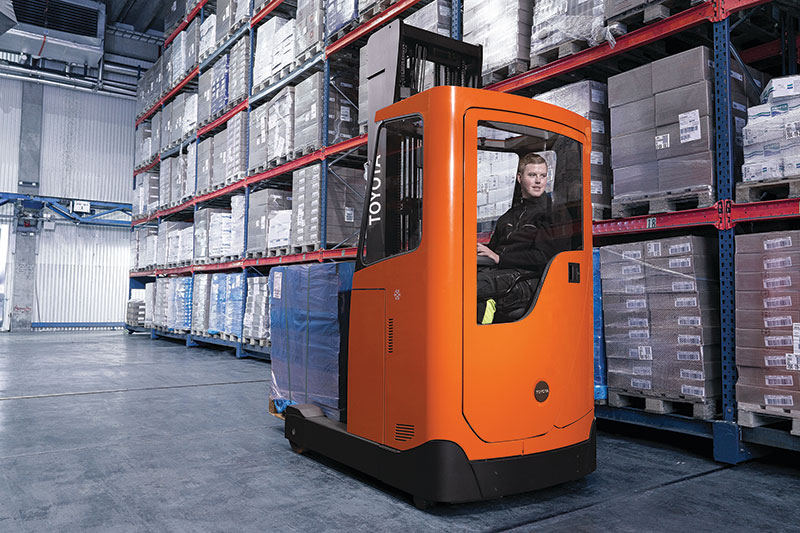Best practices for cutting cold storage condensation
Technology like lithium batteries can help in cold storage, but so can best practices.

Technology can solve for some of the challenges of operating lift truck fleets incold storage, such as motive power choices like hydrogen fuel cells or lithium batteries that match up well with cold operating conditions, but best practices can also help.
Many companies with cold storage DCs successfully operate electric truck fleets that use conventional lead-acid batteries, though outfitted for low temperature-condition comfort with features like heated seats. For example, Vertical Cold Storage, based in Bolingbrook, Ill., uses electric lift trucks fromCrown Equipmentin its cold storage operations, saysTomasz Gacek, regional maintenance manager for the cold storage warehouse operator.
The trucks do have features like heated seats, back pads and arm rests, to add warmth for operators, which reduces the need for them to leave cold storage to warm up. Frequently moving from cold storage to an ambient part of the warehouse leads to condensation, which can refreeze upon return to cold storage, and trigger more wear and tear on trucks, electrical connectors and possibly cause downtime.
But condensation issues can be reduced with best practices. “A tip for reducing condensation from going in and out of the freezers is getting the operators comfortable and in warm clothing, and installing any heating options that prevent the operators from needing to constantly come in and out,” says Gacek. “Another option, if there is available space is to strategically put chargers in rooms that are closer to dock temperatures (35°F to 45°F) instead of heated areas that will only magnify the condensation, in addition to safety hazards from slipping on the condensate that drips from the equipment.”
Lead-acid batteries also need careful maintenance practices, adds Gacek. “Warehouses need to make sure the batteries are equalized on a timely basis and watered immediately upon finishing of the equalization cycle when the battery is hot, to prevent the battery overflowing, causing a mess, and degrading battery life. Also be sure to use clean and de-ionized water during preventative maintenance, which aids in keeping the batteries running at peak performance.”
In addition to working with truck dealers to obtain cold storage features on trucks, says Gacek, it also makes sense to opt for appropriate computer gear. “When it comes to components like scanners and computers on the trucks, we make sure it’s all rated for freezing conditions and that includes heating elements to keep them running well and, no pun intended, freezing up on us when they get too cold,” Gacek says.
Motive power choices like lithium do eliminate some cold storage challenges, though it should be noted these batteries are more expensive than lead-acid batteries on an upfront price basis. However, unlike other power sources such as lead-acid, lithium-ion batteries (LiBs) are built to be completely sealed and are therefore protected from the effects of condensation, explainsJena-Christine Lawrence, product planning manager forToyota Materials Handling.
“每个应用程序都是不同的,但对于high-volume operations with more than one shift, lithium-ion batteries can be a great choice. There are many applications where lithium-ion batteries make sense. But the most obvious advantages of using LiBs are found in the cold storage industry for one primary reason: condensation,” Lawrence adds.
Certain LiB chemistries can make a difference, adds Lawrence. Lithium-ion cells operate most effectively in temperatures ranging from -4°F up to 140°F, but certain lithium chemistries can expand that range allowing LiBs to function better and last longer in extreme conditions.
“A battery with a chemistry of lithium-iron phosphate or nickel cadmium, for example, performs better in cold applications than other types—effective in temperatures as low as -25°F degrees,” says Lawrence.
然而,增加了劳伦斯,多种因素参与moving to LiBs, including higher sticker cost and the change management involved in using opportunity charging with LiBs versus the battery swapping common with lead-acid. Thus, LiBs might not suit every operation, even for cold storage.
Lawrence agrees that it makes sense to outfit trucks for cold storage with appropriate comfort features such as heated elements or even a fully enclosed, heated cabs. Like many lift truck decisions, such options do add some cost, but pay off over the operational lifespan by supporting more throughput, since with a heated, enclosed cab, operators can keep their trucks working in the cold.
“We really think the heated, cold store cabin option will be popular,” says Lawrence. “We see this as an innovative solution to an obvious challenge in cold storage, and believe that by increasing operator comfort, the heated cold store cabin option will result in increased productivity.”

Article Topics
Toyota Material Handling News & Resources
Reverse Logistics: Best Practices for Efficient Distribution Center Returns Exploring Customized Forklift Solutions Toyota Material Handling | Products: Industrial Tow Tractor Video Your telematics data to-do listLatest in Logistics
Echo’s Hurst takes a look at key logistics and transportation trends at SMC3 Connections Prologis announces plans to purchase 14 million square-foot industrial portfolio from Blackstone Real Estate National diesel average falls, for the week of June 26, reports EIA New BlueGrace Logistics Index highlights industry sentiment for Q3 inventories, revenues, and orders DAT Freight & Analytics: pros and cons of logistics outsourcing for shippers Breakthrough’s new study focuses on key shipper and carrier goals over the next 12 months DHL expands its presence in Orlando with move into new facility More LogisticsAbout the Author
Subscribe to Logistics Management Magazine

Find out what the world's most innovative companies are doing to improve productivity in their plants and distribution centers.
Start your FREE subscription today.
June 2023
万博2.0app下载

Latest Resources






